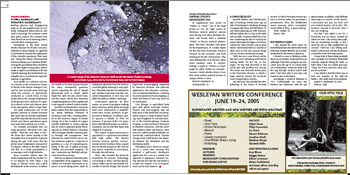Shasha Seminar
 Melting glaciers and disappearing polar ice are two tangible signs of a virtually undisputed phenomenon—the earth is warming. Yet scientists cannot give policy makers the certainty they seek about how much warming, when, and with what consequences. Participants in the third annual Shasha Seminar for Human Concerns, endowed by James Shasha ’50, gathered in November to consider the implications of this scientific uncertainty. Their topic was “Saving the Planet: Environmental Decision Making in an Uncertain World.” Among the possibilities they considered is one that ought to keep policy makers awake at night: an acceleration in the rate of global warming that would lead to catastrophic rises in sea level and major disruptions in agriculture. Jerry Melillo ’65, co-director and senior scientist at the Ecosystems Center of Woods Hole Marine Biological Lab, said his own research raises warnings about this scenario. In experiments conducted in a small forest, he has shown that as the average temperature of the ground rises, soil loses its capacity
Melting glaciers and disappearing polar ice are two tangible signs of a virtually undisputed phenomenon—the earth is warming. Yet scientists cannot give policy makers the certainty they seek about how much warming, when, and with what consequences. Participants in the third annual Shasha Seminar for Human Concerns, endowed by James Shasha ’50, gathered in November to consider the implications of this scientific uncertainty. Their topic was “Saving the Planet: Environmental Decision Making in an Uncertain World.” Among the possibilities they considered is one that ought to keep policy makers awake at night: an acceleration in the rate of global warming that would lead to catastrophic rises in sea level and major disruptions in agriculture. Jerry Melillo ’65, co-director and senior scientist at the Ecosystems Center of Woods Hole Marine Biological Lab, said his own research raises warnings about this scenario. In experiments conducted in a small forest, he has shown that as the average temperature of the ground rises, soil loses its capacity
to absorb carbon and releases more to the atmosphere, where it traps heat. His work underscores one of the greatest concerns of climate scientists who worry that our limited understanding of the ways that the land and oceans absorb and release greenhouse gases may mean that surprises are in store. Yet scientific uncertainty does not imply ignorance. “We know a lot,” says Melillo. “That fact, very often, is lost.” We know that carbon dioxide in the atmosphere has increased by 31 percent during the past 1,000 years; that the global mean temperature increased by 0.6 degrees Celsius in the 20th century; and that, as a result, precipitation is increasing in mid to high latitudes. Most scientists believe that the earth’s temperature will rise another 1.5 to 6.0 degrees by 2100. That’s a big range, in climatic terms, and a great deal depends on the outcome. Scientists are unable to be more precise because too many unanswered questions remain regarding the role of natural phenomena such as clouds, which shade the earth but also absorb heat, and the oceans, which have extremely complicated patterns of heat uptake and a vast capacity to absorb carbon dioxide.
Scientific uncertainty does not excuse policy makers from the responsibility to act, insists Wesleyan Professor of Economics Gary Yohe, a leading authority on the economic impact of climate change. He is the co-author of a paper recently published in Science arguing that we need to approach global warming just as Federal Reserve Chairman Alan Greenspan handles monetary policy: through risk management. Yohe advocates an initial $10/ton tax on carbon emissions (equal to a nickel tax on gasoline) as a way of responding prudently to the risk of global warming. “Modest but persistent hedging,” he says, “maximizes our flexibility and prevents doors from closing.” Yohe has no illusions about the political palatability of his suggestion. Policy makers use scientific uncertainty as an excuse to avoid taking action, aided by contrarians who have hired PR firms to assert that global warming is not a problem. The public may also be confused, he says, because some areas may have consistent temperatures or even may cool while the earth as a whole is warming. Government agencies, by their nature, are prone to postpone making policy decisions about global warming until more information is available,
noted Marc Eisner, professor of government at Wesleyan. In addition, public opinion is volatile. In 1990, for instance, 75 percent of the U.S. population identified themselves as environmentalists, but by 2000 that figure had slipped to 47 percent.
The impact of global warming on agriculture is a significant uncertainty with high stakes. The Shasha Seminar keynote speaker, environmental activist Vandana Shiva, argued that we should respond to the risk the way nature responds to uncertainty, through diversification. Shiva, who founded the Research Foundation for Science, Technology, and Ecology in India, said that specialization makes species particularly vulnerable to climate change. She decried large-scale monocropping supported by extensive fertilizer and pesticide applications. She advocates—and practices on experimental farms—reverting to ancient practices of intercropping, in which the failure of one crop need not be catastrophic. Can changes to agriculture keep pace with global warming? Diversification and intercropping may not help areas of the world that see precipitation drop as a result of global warming. Sara Hoagland ’78, associate director of the Interdisciplinary Graduate Program in Environmental Resources at Stanford University, cited the direct link between water and famine. Even now, 825 million people worldwide are chronically undernourished. Climate change easily could worsen the disparity between the developed and the developing world. Participants had a chance to set policy in a mock town meeting that involved a golf-course developer’s application for a site in a coastal area expected to experience sea-level rise. The exercise was like the real world in at least one respect: a lot of disagreement and no easy answers.
